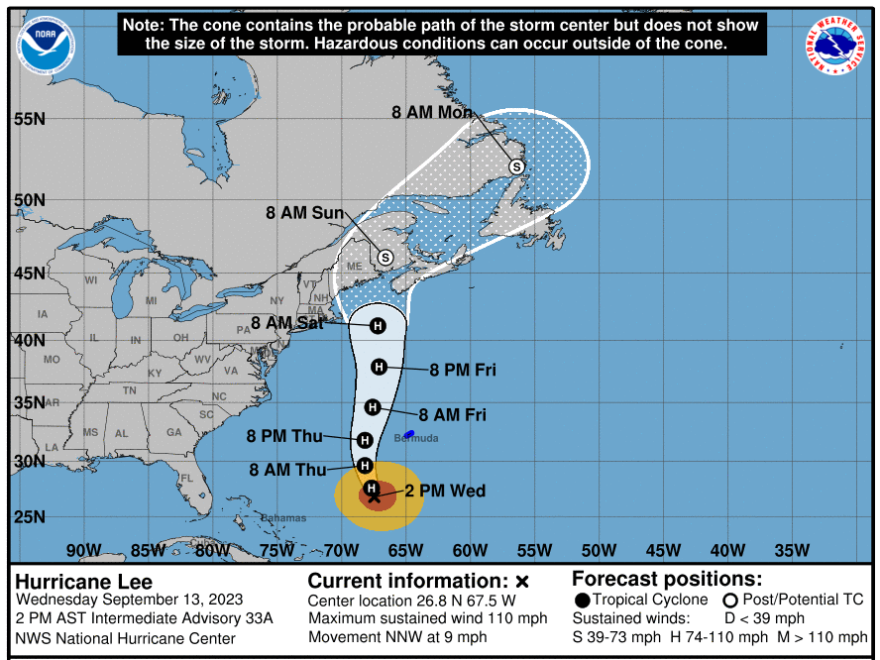MIAMI — While Hurricane Lee churns far offshore in the Atlantic Ocean off the U.S. coast with a possible weekend impact in New England or Canada, there's another danger lurking — rip currents.
They usually receive little attention but are the third leading cause of weather fatalities and forecasters. Over the last 10 years, rip currents have killed more people than tornadoes or hurricanes. This year has already been particularly bad with 76 deaths reported through August.
As Hurricane Lee moves north through the Atlantic, National Hurricane Center director Mike Brennan says his top message for people on the East coast is: watch out for rip currents. "Hurricanes, even if they're far offshore can produce dangerous surf and rip current conditions. Please be safe if you're going to get in the water."

Hurricane Lee, once a category 5 storm with 165 mile per hour winds, has weakened as it's moved north over cooler waters. But meteorologist Jase Bernhardt at Hofstra University says the storm has also grown larger. "When it's a large powerful hurricane like Lee is, it's going to kick up a lot of waves," he says. "And when you have strong, heavy surf, that creates a prime avenue for rip currents to form along the coastal facing beaches."
Rip currents form when heavy surf piles up water near the shoreline. Bernhardt says the water then accelerates and rushes downhill, pulling anything caught in it, including swimmers out to sea. "Especially," he says, "if there is a gap in say, a sandbar, if there's a narrow passage for the water to go through." He compares it partially closing the opening on a garden hose. "It's going to be accelerated more quickly," he says.
In this country, rip currents pose a danger to beachgoers everywhere, including the Great Lakes. But the most dangerous place recently has been in Florida. In June, at least 11 people died in rip currents in Panama City Beach and other nearby areas on Florida's panhandle.
The director of beach safety in Panama City Beach, Daryl Paul says in most areas, rip currents come and go, depending on the surf, the tides and other factors. On his beach, rip currents are created by almost constant wind, traveling over 600 miles of open water in the Gulf. He says, "If you have a strong, 15 mile an hour southwest wind that's hitting Panama City Beach, your rips are going to be powered and they're not going to stop. This rip's always under power. Its foot is always on the gas."
Paul says his lifeguards have rescued more than 200 people from rip currents this summer. He's put up a double red flag closing the water to swimming more than 20 times so far. On those days, he says he's the most unpopular man on Panama City Beach. "I've met dudes from Australia," he says. "They come down, they're like, 'Ah mate, why you closin' the water, mate? This is nothing, this is nothing. You're crazy.' Well, we're flying it for rip currents."
Experts say the problem is that most people don't know anything about rip currents, the risk they pose, and how many people die because of them each year. Paul says it doesn't make sense, but beachgoers are much more worried about sharks, which kill just a handful of people each year. "I find myself having to just say, 'No, it's rip currents, rip currents, rip currents.' They're like. 'sharks, sharks, sharks?' It's like 'No!' It's an ongoing battle for us."
Rip currents move quickly, as fast as 5 miles per hour. They don't pull you under. Paul says if you're caught in one, you should swim parallel to the shore. But the most important thing is to stay calm. "If all you can do is float, then just float on your back," he says. "Throw an arm up and start waving. Let the current take you until it lets go."
The National Weather Service now issues rip current forecasts for coastal communities. Unlike fatalities in hurricanes, tornadoes and other weather events, experts say deaths from rip currents should be almost entirely preventable.
Copyright 2023 NPR. To see more, visit https://www.npr.org.




